The three-step close

How to ask for and get the money. Or how I learned to dance with the fear in my lizard brain.
Whenever someone I know, who runs a small creative firm, or is a writer or designer, tells me they struggle with asking for and getting the fees they need I always recommend the three-step close.
I know about this struggle and the anxiety that goes with asking for the money. Why? Because I’ve always struggled with it myself. I still struggle, even though I have successfully asked for hundreds of thousands and even millions and gotten the money. But the feelings of anxiety and even outright fear are still with me.
Along the way, I’ve discovered that the amount doesn’t matter. Asking for a few hundred can be just as anxiety-producing as asking for thousands, or hundreds of thousands, for that matter.
That anxiety is what led me to create my three-step close.
Why the angst?
The reason for the fear is simple. You’re not in control. You could be challenged. You could be told that you’re not worth it, or that you don’t have the chops, or you’re not qualified. Or as my father used to say, “you’re stupid!” So how could you possibly be worth anything let alone what you’re asking for?
My father’s voice confirming that I’m not worth it is always dancing with my lizard brain somewhere in the back of my head.
An awful lot of creatives I know struggle with something similar.
So what do they do instead of asking for the money? They write an email, a text, or worse an elaborate proposal. That’s what I used to do too.
And when I ask them why they feel better writing it out they often say that it gives them a chance to go over every word carefully. A chance to deeply consider every aspect of the job before committing. A chance to craft the logic of their ask completely.
I understand that deep need to spell it all out, but I’m pretty sure that the real reason is they are just afraid of rejection. And as I said I’m intimately familiar with that fear. And, still feel it.
The scenario
A prospective client, or an existing client, has asked you for a proposal. You’ve discussed the work. Maybe they’ve sent you a description of what they need.
In any case, you’ve had a bit of time to consider how you’d approach the work. You’ve had a chance to question the client and you have a good understanding of what’s needed. At this, point you’ve made notes and are clear about what the deliverables will be. You know how long it will take to do the work and you’ve decided what you are going to charge.
Now it’s time to talk to your client.
It’s best to do this in person but video is fine, especially with the pandemic. Voice alone is not as good but is acceptable if it’s all that you can arrange. What’s not acceptable is sending ahead an email, text, or proposal with your fee in it.
Okay, now here you are on Zoom or in the room with, hopefully, your soon to be, client.
The three-step close
Step one:
Describe the deliverables you’ve determined are required to meet the client’s needs. Carefully watching your client for their reaction as you do so. When you’ve completed your description ask your client, “how does that sound?”
If they say great move on to spelling out the schedule.
It’s a good sign if they ask for a change or adjustment in the deliverables you’ve described. It means they are with you in spirit at the very least. Maybe you forgot to include something or maybe the discussion has made the client think of something they’d like added. Fantastic, they’re engaged!
If you’re able adjust your deliverables on the spot do so and ask the question again, “how does that sound?”
If you are unable to adjust the deliverables on the spot, ask them if you can get back to them on the point they raised and move on.
Step two:
Describe the schedule. And keep this as simple as possible, with something like, “projects like this will take about eight weeks. How does that sound?”
At this point, the client will be wondering what the costs will be so it’s time go for it!
Step three:
Time to talk fees. Again, I like to keep it as simple as possible, “with eight weeks to do the work and the deliverables we’ve agreed the fee is $50,000.
Now it’s time to be quiet. Say nothing more and hold the client’s gaze as best you can, while you wait. They may simply say “yes, can’t wait to work with you on this”.
If they ask for a written proposal say, “In my experience, it’s far more efficient to follow up with a contract. I’ve found that it’s not a good use of my client’s time or that of my own to write proposals.”
If they agree you can follow up with a contract. Or they may want to discuss it further. And discussion – even if it results in changes – is just as good as a simple go-ahead.
Why it works
First of all, it shows that you are a knowledgeable professional, comfortable talking about money and you are experienced enough about what is required to discuss the scope fluently.
Second, starting with a detailed discussion of the work will, in my experience, greatly reduce your anxiety. It sure does for me.
Through the back and forth of this project defining conversation you’ll form a bond with your client by showing how engaged you are in meeting their needs. This is always flattering for them and reassuring for you.
They will be able to talk, clarifying their growing understanding of their need and what’s required to fill it. And you’ll gain additional insight that will shape and define the scope.
Best of all, the discussion will make them feel secure in their professional area which will further their good feelings about you. Remember they are human too, subject to their own feelings and anxieties.
Lizzard diminished
As the discussion unfolds your anxiety will drop dramatically as you see the client embracing the jointly defined approach.
So by the time you get to the money, you will feel that you have a fairly solid relationship with the client. That feeling has always helped me, and my clients who use the three-step close, gain enough confidence to say the number and wait for a response.
Once a verbal agreement is reached follow up with a contract to seal the deal.
And that’s how I learned to dance with my lizard and win.



2 Comments
Thanks Ted. Yup, the struggle is real! This is a great reminder that discussing the work involved with client before jumping to fees is critical to validating your costs. I also find at times with those conversations that the deliverables will shift, if not grow once they understand the process further. – Mitch
Yes! You can grow the opportunity this way. Well put Mitch